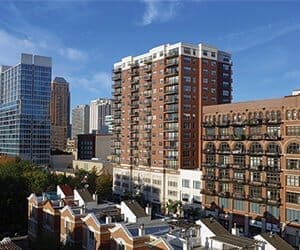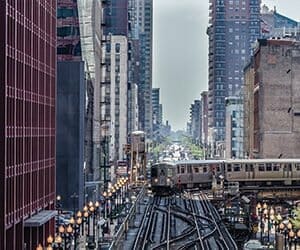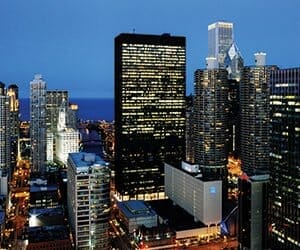The city of Chicago is made up of 77 distinct “community areas” – and over 100 neighborhoods – each with its own unique characteristics. More than half of our graduate students live near the University’s campus in the Hyde Park and Woodlawn neighborhoods (within walking, biking, or campus shuttle distance), but many also choose to live elsewhere in the city and commute to campus. Here we’ve provided some information on where UChicago graduate students live throughout the city.
Graduate Students in Chicago
Number of UChicago Graduate Students
- 1-5
- 6-20
- 21-50
- 51-100
- 100+
- None
In and Around Hyde Park
Hyde Park Overview
Hyde Park, home to the University of Chicago, is a diverse, historic neighborhood on the South Side of Chicago. It is located approximately seven miles from downtown Chicago, with Lake Michigan’s waterfront to the east, Washington Park to the west, Kenwood to the north, and Woodlawn to the south.
Many of the University’s students, faculty, and staff live in or near Hyde Park, thanks to its proximity to campus and its numerous cultural, educational, and religious institutions as well as restaurants, coffee shops, performance venues, and more.
Hyde Park is also home to several important museums, including the Museum of Science and Industry and the DuSable Museum of African American History, and campus itself boasts the Smart Museum of Art, the Renaissance Society, and the Oriental Institute.
Housing in the Hyde Park Area
Hyde Park, along with neighboring South Kenwood and North Woodlawn, offers a full range of housing options, from high-rises and luxury buildings with lake views, to charming vintage three- or four-story walk-up buildings. The cost of renting in Hyde Park, as in any neighborhood, depends on many factors, including building amenities, size, and location (proximity to campus, shopping centers, or the lake, for example). In general, it will be much less expensive to share an apartment with one or more roommates than to rent a studio or one-bedroom apartment by yourself.
If you opt for housing in the Hyde Park area, a good way to consider location is to look at the routes for the University’s NightRide shuttle service. It is designed so that each route begins on campus, and any location in the Hyde Park area is within two blocks of a shuttle stop.
- East Hyde Park: This area is home to a mix of options, including the majority of the luxury and high-rise buildings. It is close to Lake Michigan, and provides easy access to public transportation, shopping, and other amenities. Given all of these features, rents may be higher than in other parts of the neighborhood, and street parking in much of this area is limited. It is a 15-25 minute walk to campus.
- Central and West Hyde Park: Primarily composed of older, walk-up style buildings, these areas offer a shorter walk to campus – usually 5-15 minutes. Central Hyde Park is close to shopping centers and restaurants; West Hyde Park is primarily residential. Both areas offer somewhat easier street parking and moderate rental prices, especially for shared multi-bedroom apartments, which are plentiful.
- North Hyde Park/South Kenwood: Also primarily residential, these areas have a mix of apartments and beautiful landmark homes – and even the occasional converted coach house. Access to shopping areas may be easier, but the walk to campus is 15-25 minutes. 53rd Street is Hyde Park’s main retail district. Several stores and restaurants line the street such as Hyde Park Produce, LA Fitness, Cedars Mediterranean Kitchen, Clarke’s Restaurant, Akira, CorePower Yoga, Kilwins Chocolates and Fudge, Starbucks, Binny’s Beverage Depot and numerous others.
- South Hyde Park/North Woodlawn: These residential areas are close to campus – especially to the graduate programs housed south of the Midway Plaisance – but are further from the commercial areas of Hyde Park. Rent prices here are often lower, but students may find having a car desirable for shopping and other errands.
Getting Around Hyde Park
Walking or Biking
Hyde Park is approximately a mile square, so it is typically possible to walk between any two points in the neighborhood in under 30 minutes. Biking is possible almost year-round, and major streets offer bike lanes. Bike racks are available outside of almost every University building. There are also bike-sharing options, including Divvy Bikes, which has several stations in Hyde Park and throughout the city, and offers a discount to University of Chicago students.
Campus Transportation
Besides walking or biking, the University offers a variety of transit options. During the day, the Chicago Transit Authority (CTA) operates two routes (#171 and #172), which are free to University students and employees. In addition, the University provides several shuttle routes, distinctive white buses which start from the center of campus and run various routes around Hyde Park, North Woodlawn, and South Kenwood. A convenient transit apphttps://safety-security.uchicago.edu/en/transportation/passiogo lets you track each of the buses and shuttles.
Daytime CTA Buses
UGo Daytime Shuttles
UGo NightRide Shuttles
Public Transit
No matter where you live in Hyde Park, you will want to spend plenty of time exploring the city of Chicago. The area is served by several public transit options, including buses and trains that are part of the CTA, as well as Metra Electric trains. Traveling via the CTA using their Ventra Card system has the advantage of allowing you to transfer between buses and trains all over the city, while the Metra train runs on a fixed schedule and is the fastest route if you are only headed as far as downtown.
More information on public transit:
CTA
Metra
Parking
As in all big cities, parking in Hyde Park can be a challenge. After 8 a.m. on weekdays, expect to spend 30 minutes or more finding street parking within several blocks of campus; in the residential areas, the same will be true early in the morning and after 5 p.m. If you plan to drive to campus, you may want to apply for a monthly permit for one of the campus parking lots, which is currently $90/month. If you live in Hyde Park and own a car, the ease of street parking varies widely across the neighborhood; very few buildings offer off-street parking, and if it is available, expect to pay $90/month or more in addition to your rent. If your car has Illinois license plates, you will need to purchase an annual street parking permit (“City Sticker”) to park on the streets in Chicago.
Other Chicago Neighborhoods
Although the best way to learn about a neighborhood is to explore it in person, we have compiled some information on the five neighborhoods after Hyde Park that are the most popular to live in among UChicago graduate students, arranged from south (closest to Hyde Park) to north (farthest away).
Public Transit
Students who live outside of the University’s transit service areas often choose to use public transportation to commute to campus. The city of Chicago is served by several public transit options, including buses and trains that are part of the Chicago Transit Authority (CTA), as well as Metra Electric trains. Traveling via the CTA using their Ventra Card system has the advantage of allowing you to transfer between buses and trains all over the city, while the Metra train runs on a fixed schedule and is the fastest route if you are only headed as far as downtown. For each neighborhood below, some options for public transit to campus are listed.
More information on public transit:
CTA
Metra

South Loop
The South Loop is part of the Near South Side of Chicago, and is one of the fastest growing neighborhoods in the city. It is in close proximity to some of Chicago’s most popular attractions, including Soldier Field, the Field Museum, Shedd Aquarium, and Adler Planetarium. In addition to UChicago students, the South Loop is also a popular location for students and young artists from other colleges and universities in the city, including DePaul, Columbia College Chicago, and the School of the Art Institute of Chicago.
With several shopping areas and downtown within walking distance, and most apartments located in new, high-rise buildings, rent prices in this area can be very high. However, it is also among the most convenient neighborhoods in the city for a commute to Hyde Park.
Transportation to Hyde Park:
Trains: CTA Red Line (Roosevelt, Cermak/Chinatown), Green Line (Roosevelt, Cermak/McCormick Place), or Metra (Museum Campus/11th Street, 18th Street)
Buses: #55 Garfield (connecting Red and Green lines to Hyde Park), #2 Hyde Park Express (rush hour only), #192 U of C Hospitals Express (rush hour only), #6 Jackson Park Express
Distance: 6 miles
Estimated Travel Time: 20-30 minutes

Pilsen
Pilsen is located west of the South Loop, and is also home to many students interested in arts, culture, and music. Because of its proximity to the University of Illinois at Chicago, the University of Chicago, and other colleges in the city – as well as its affordable rent prices – there is a large student population in the area. Pilsen, known historically as a predominantly Mexican-American neighborhood, is now blended with artists and students, making it one of the most diverse communities in Chicago.
Housing options include single-family homes, apartments, and new construction, which are often large and reasonably affordable. Pilsen is a quick drive to UChicago’s campus, but public transportation offers no direct connection to Hyde Park; the most direct routes are primarily by bus, and you can expect to transfer at least once between Pilsen and Hyde Park.
Transportation to Hyde Park:
Trains: Bus to CTA Green Line (Cermak/Paulina, then transfer to bus), CTA Pink Line (Damen, 18th, then transfer downtown to bus or train)
Buses: #8, to #55, or #60, #7, #21 to the Loop (transfer to #192, #2, #6, or train)
Distance: 8 miles
Estimated Travel Time: 50-60 minutes

The Loop
As Chicago’s official downtown area, the Loop – named after the elevated train tracks which circle the area – is a hub for finance, transportation, government, shopping, tourism, and culture. The Loop is one of the busiest areas of Chicago for commerce and the arts, and has also become a popular residential neighborhood. Condominiums and studio apartments constitute the majority of the options in the Loop, and they generally have luxury amenities such as a gym, doorman, storage, and in-unit laundry. However, since you are in the heart of Chicago’s downtown, apartments will be smaller and much pricier than other areas.
With five train lines, several buses, and the Metra all running through the Loop, you should find that a car is not necessary.
Transportation to Hyde Park:
Trains: CTA Red Line (Lake, Monroe, Jackson, and Harrison) and Green Line (Adams/Wabash, Randolph/Wabash, State/Lake, Clark/Lake); Metra (Millennium, Van Buren)
Buses: #6 Jackson Park Express, #2 Hyde Park Express (rush hour only), #192 U of C Hospitals Express (rush hour only), #55 Garfield (connecting Red and Green lines to Hyde Park)
Distance: 7 miles
Estimated Travel Time: 25-35 minutes

Near North Side
The Near North Side is composed of a handful of other, smaller neighborhoods—Streeterville, River North, Gold Coast, and Old Town. The area is situated between the Loop to the south and Lincoln Park to the north.
The Near North Side is very popular with shoppers and tourists, playing host to the Magnificent Mile shopping district, Navy Pier, the comedy clubs of Old Town, and innumerable restaurants, bars, parks, and nightclubs. There are even a few beaches, and the Lakefront Trail connects the area both to neighborhoods to the north as well as Hyde Park to the south.
The Near North Side is a mix of old mansions, luxury high-rise condominiums, and renovated walk-ups. As one of the most exclusive and expensive areas in Chicago, the rent in Near North can be quite high. Public transportation makes the area easily accessible – the Red, Brown, and Purple Line trains all run throughout the neighborhood, along with several bus lines.
Transportation to Hyde Park:
Trains: CTA Red Line (North/Clybourn, Clark/Division, Chicago, and Grand)
Buses: #55 Garfield or #192 U of C Hospitals Express (connecting Red and Green lines to Hyde Park, #192 rush hour only), #2 Hyde Park Express (rush hour only)
Distance: 11 miles
Estimated Travel Time: 50-60 minutes

Lincoln Park
Lincoln Park includes both the park of the same name, as well as the residential areas to the west. Inside the park is the Lincoln Park Zoo, one of the oldest zoos in the country and a popular (and free) attraction. There are plenty of bars, pubs, and other nightlife spots throughout the neighborhood, and with DePaul University in the center of Lincoln Park, it is a popular place for college students.
Lincoln Park real estate is a mix of three- and four-story apartment buildings, single-family homes, condominiums, and high-rises providing housing options for families, college students, and young professionals. A wide range of public transit options make it easy to get around the city, though parking everywhere on the north side is a challenge.
Transportation to Hyde Park:
Trains: CTA Red Line (Fullerton)
Buses: #55 Garfield or #192 U of C Hospitals Express (connecting Red and Green lines to Hyde Park, #192 rush hour only)
Distance: 12 miles
Estimated Travel Time: 55-60 minutes